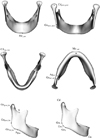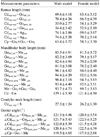1. Franca C, Levin-Plotnik D, Sehgal V, Chen GT, Ramsey RG. Use of three-dimensional spiral computed tomography imaging for staging and surgical planning of head and neck cancer. J Digit Imaging. 2000; 13:24–32.

2. Elolf E, Tatagiba M, Samii M. Three-dimensional computed tomographic reconstruction: planning tool for surgery of skull base pathologies. Comput Aided Surg. 1998; 3:89–94.
3. Troulis MJ, Everett P, Seldin EB, Kikinis R, Kaban LB. Development of a three-dimensional treatment planning system based on computer tomographic data. Int J Oral Maxillofac Surg. 2002; 31:349–357.
4. Kragskov J, Sindet-Pedersen S, Gyldensted C, Jensen KL. A comparison of three-dimensional computed tomography scans and stereolithographic models for evaluation of craniofacial anomalies. J Oral Maxillofac Surg. 1996; 54:402–412.

5. Cheng AC, Wee AG. Reconstruction of cranial bone defects using alloplastic implants produced from a stereolithographically-generated cranial model. Ann Acad Med Singapore. 1999; 28:692–696.

6. Kermer C, Lindner A, Friede I, Wagner A, Millesi W. Preoperative stereolithographic model planning for primary reconstruction in craniomaxillofacial trauma surgery. J Craniomaxillofac Surg. 1998; 26:136–139.

7. Zachow S, Lamecker H, Elsholtz B, Stiller M. Reconstruction of mandibular dysplasia using a statistical 3D shape model. Int Congr Ser. 2005; 1281:1238–1243.

8. Gateno J, Xia JJ, Teichgraeber JF, Christensen AM, Lemoine JJ, Liebschner MA, et al. Clinical feasibility of computer-aided surgical simulation (CASS) in the treatment of complex craniomaxillofacial deformities. J Oral Maxillofac Surg. 2007; 65:728–734.
9. D'Urso PS, Barker TM, Earwaker WJ, Bruce LJ, Atkinson RL, Lanigan MW, et al. Stereolithographic biomodelling in craniomaxillofacial surgery: a prospective trial. J Craniomaxillofac Surg. 1999; 27:30–37.
10. Mavili ME, Canter HI, Saglam-Aydinatay B, Kamaci S, Kocadereli I. Use of three-dimensional medical modeling methods for precise planning of orthognathic surgery. J Craniofac Surg. 2007; 18:740–747.
11. Hwang HS, Hwang CH, Lee KH, Kang BC. Maxillofacial 3-dimensional image analysis for the diagnosis of facial asymmetry. Am J Orthod Dentofacial Orthop. 2006; 130:779–785.
12. Xia J, Ip HH, Samman N, Wang D, Kot CS, Yeung RW, et al. Computer-assisted three-dimensional surgical planning and simulation: 3D virtual osteotomy. Int J Oral Maxillofac Surg. 2000; 29:11–17.

13. Xia J, Samman N, Yeung RW, Shen SG, Wang D, Ip HH, et al. Three-dimensional virtual reality surgical planning and simulation workbench for orthognathic surgery. Int J Adult Orthodon Orthognath Surg. 2000; 15:265–282.

14. Cevidanes LH, Bailey LJ, Tucker GR Jr, Styner MA, Mol A, Phillips CL, et al. Superimposition of 3D cone-beam CT models of orthognathic surgery patients. Dentomaxillofac Radiol. 2005; 34:369–375.
15. Katsumata A, Fujishita M, Maeda M, Ariji Y, Ariji E, Langlais RP. 3D-CT evaluation of facial asymmetry. Oral Surg Oral Med Oral Pathol Oral Radiol Endod. 2005; 99:212–220.
16. Lamecker H, Zachow S, Wittmers A, Weber B, Hege HC, Elsholtz B, et al. Automatic segmentation of mandibles in lowdose CT data. Int J Comput Assist Radiol Surg. 2006; 1:suppl 1. 393–395.

17. Ahn JS, Lee KH, Hwang HS. A study on the 3-D standard value of mandible for the diagnosis of facial asymmetry. Korean J Orthod. 2005; 35:91–105.

18. Park SH, Yu HS, Kim KD, Baik HS. A proposal for a new analysis of craniofacial morphology by 3-dimensional computed tomography. Am J Orthod Dentofacial Orthop. 2006; 129:600.e23–600.e34.

19. Kim KH, Choy KC, Kim HG, Park KH. Cephalometric norms of the hard tissues of Korean for orthognatic surgery. J Korean Assoc Oral Maxillofac Surg. 2001; 27:221–230.

20. Brief J, Hassfeld S, Dauber S, Pernozzoli A, Munchenberg J, Redlich T, et al. 3D norm data: the first step towards semiautomatic virtual craniofacial surgery. Comput Aided Surg. 2000; 5:353–358.
21. Eufinger H, Wehmoller M, Machtens E, Heuser L, Harders A, Kruse D. Reconstruction of craniofacial bone defects with individual alloplastic implants based on CAD/CAM-manipulated CT-data. J Craniomaxillofac Surg. 1995; 23:175–181.
22. Brooks SL. Computed tomography. Dent Clin North Am. 1993; 37:575–590.

23. Cavalcanti MG, Haller JW, Vannier MW. Three-dimensional computed tomography landmark measurement in craniofacial surgical planning: experimental validation in vitro. J Oral Maxillofac Surg. 1999; 57:690–694.





 PDF
PDF ePub
ePub Citation
Citation Print
Print













 XML Download
XML Download